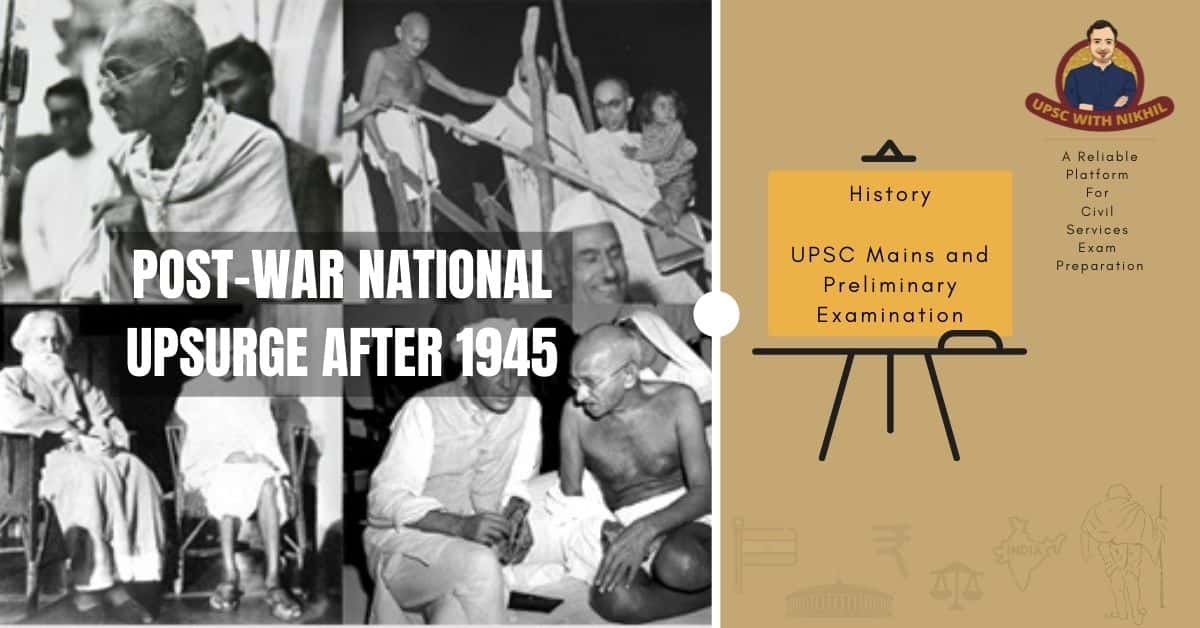Post-war National Upsurge After 1945
The end of World War II signalled a significant shift. The political stage witnessed a wide range of popular initiative from then until the dawn of freedom in 1947. The country-wide strike wave, the Tebhaga Movement, the Warlis Revolt, the Punjab kisan morchas, the Travancore people's struggle (especially the Punnapra-Vayalar episode), and the Telengana Movement are among the struggles of workers, peasants, and people of the native states that we are compelled to leave out of our purview. These movements were anti-imperialist in nature, as the direct oppressors they opposed were also the vested interests that provided the Raj with social support, but they did not directly oppose the colonial regime.
• The end of the war was met with a collective sigh of relief in India. Its few benefits, such as windfall gains and super-profits for capitalists and job opportunities for the middle classes, were far outweighed by the destruction and misery it wreaked.
• The colony was groaning under the weight of the war effort. The land was plagued by famine, inflation, scarcity, hoarding, and black-marketing. Despite the heroic actions of a people without a leader, the Quit India Movement was put down in just eight weeks.
• Pockets of resistance, where the flame was kept alive, couldn't last long. When Congress leaders were released from prison in mid-June 1945, they expected to find a demoralised populace, benumbed by the repression of 1942, befuddled by the lack of leadership, and battered by the hardships of war.

• They were surprised to find tumultuous crowds awaiting them, eager to do something, restless, and adamantly anti-British. The brave had been strengthened by repression, while the fence-conscience sitter's had been stirred. After more than three years of repression, political energies were resurfacing, and the people's expectations were now heightened by the release of their leaders.
• The general consensus was that the release would signal the start of a period of rapid political advancement. On hearing that Jawaharlal Nehru was to be released, crowds flocked to the Almora jail gates. They stood outside the Bankura jail, where Maulana Azad was being held, for a long time. More than half a million people lined the streets of Bombay to greet their leaders when the Congress Working Committee met, braving the rain. When the leaders travelled to Simla for the Viceroy's conference, similar scenes were witnessed.
• Villagers from all over Simla gathered and sat atop trees for hours, hoping to catch a glimpse of their leaders.
• After the war, the Labour Party, which had come to power in Britain, was eager to resolve the Indian problem. As a result, the Congress's ban was lifted, and elections were called. People were ecstatic at the prospect of popular ministries, and they flocked to election meetings in large numbers — 50,000 on average, and a lakh or more when all India leaders were expected.
• Nehru, a veteran campaigner in the 1937 elections, admitted that he had never seen such large crowds or such frantic excitement before. Candidates did not need to canvass for votes or spend money unless they ran in constituencies where nationalist Muslims were elected. People had not only flocked to the meetings, but had also rallied behind the Congress at the ballot box, according to the election results.
• In the provincial elections, the Congress won over 90% of the general seats (including twenty-three of the thirty-six labour seats), while the Muslim League did the same in Muslim constituencies. The election campaign's most notable feature, however, was that it sought to mobilise Indians against the British, not just voters for the elections.
• The repression in 1942 and the Indian National Army trials were two issues that were taken up and made the main plank of the election campaign. Congress leaders took up the issue of official excesses in 1942 shortly after their release from prison.
• The one side of the coin was the veneration of martyrs, while the other was the condemnation of official action. Congressmen praised the leaderless people's valiant resistance; martyrs' memorials were erected across the country, and relief funds were established for the victims.
• Repression stories were told in graphic detail, the officials responsible were named and shamed, promises of investigations were made, and threats of punishment were freely made. While such speeches, which the government failed to prevent, had a devastating effect on service morale, the rising crescendo of demands for investigations into official actions was more alarming for officials.
• The upcoming elections were likely to restore Congress ministries to power, particularly in provinces where repression had been particularly severe.
• On February 19, 1946, U.P. Governor Wylie admitted that officials in the state had “used on occasion methods which I cannot condone and which, dragged out in the cold light of 1946, nobody could defend” in 1942. Only a "gentleman's agreement" with the Congress, the Viceroy concluded, could resolve the issue.


